Industrial Ventilation - 1. Introduction
On this page
- What is covered in this document?
- What is industrial ventilation?
- Why have an industrial ventilation system?
- What is the purpose of a ventilation system?
- What are the parts of an industrial ventilation system?
- What are the basic types of ventilation systems?
- What are the main features of dilution ventilation?
- What are the limitations of dilution ventilation?
- What is local exhaust ventilation?
- What are the components of local exhaust ventilation?
- How do I know which type of ventilation system is best for my workplace?
- In general, what are limitations of any ventilation system?
- What should I know about make-up air?
What is covered in this document?
Back to topThis document is an introduction to industrial ventilation. It is part of a series of documents on this topic.
- Introduction
- Units and Measures
- Ducts
- Fans
- Hoods
- Air Cleaning Devices
- Installation and Maintenance (general)
- Troubleshooting
- Glossary of Common Terms
The above documents do not cover indoor air quality and general ventilation as used in offices, homes, and other non-industrial settings. Please see the OSH Answers document Indoor Air Quality - General for more information.
What is industrial ventilation?
Back to topVentilation is the act of bringing in "fresh" outdoor air or exchanging the air. Ventilation can be thought of as controlling the environment by using airflow.
General or natural ventilation is referred to as "dilution ventilation". Dilution ventilation is used to control exposure to airborne contaminants. It is commonly used to remove contaminants such as fumes, dusts, and vapours in order to provide a healthy and safe working environment. Dilution ventilation can be accomplished by natural means (e.g., opening a window) or mechanical means (e.g., fans or blowers that clear a general space).
Industrial ventilation systems are designed to move out (exhaust) and bring in (intake) a specific amount of air at a specific speed (velocity), which results in the removal of undesirable contaminants in a specific area or space. While all ventilation systems follow the same basic principles, each system is designed specifically to match the type of work and the rate of contaminant release by an industrial process.
Why have an industrial ventilation system?
Back to topVentilation is considered an "engineering control" to remove or control contaminants released in indoor work environments. It is one of the preferred and more effective ways to control employee exposure to contaminants released by a process into the air.
Other ways to control contaminants include:
- eliminate the use of the hazardous product,
- substitute with less toxic products,
- process change, or
- work practice change.
What is the purpose of a ventilation system?
Back to topThere are four purposes of ventilation:
- Provide a continuous supply of fresh outside air.
- Remove or dilute airborne contaminants.
- Reduce potential fire or explosion hazards.
- Maintain temperature and humidity at comfortable levels.
What are the parts of an industrial ventilation system?
Back to topAn industrial ventilation system has two main parts: a fresh air supply system and an exhaust system.
In general, the supply system is a heating, ventilation, and air-conditioning system (HVAC) and consists of:
- air inlet
- air filtering equipment
- heating/cooling equipment
- fan
- ducts
- air distribution registers
The exhaust system consists of:
- an "air intake" area
- ducts to move air from one area to another
- air cleaning device(s)
- fan(s) to bring in outside air and exhaust the indoor contaminated air
- discharge stacks
The Industrial Ventilation series of documents discuss these elements of the exhaust system.
What are the basic types of ventilation systems?
Back to topThere are two types of mechanical ventilation systems used in industrial settings:
Dilution ventilation (general ventilation) reduces the concentration of air contaminants by mixing (diluting) the contaminated air with fresh, clean, uncontaminated air. It may also help regulate the temperature and humidity of the working environment.
Local exhaust ventilation captures contaminants at, or very near, the source.
What are the main features of dilution ventilation?
Back to topDilution ventilation supplies and exhausts large amounts of air to and from an area or building. It usually involves large exhaust fans placed in the walls or roof of a building. It is used to help prevent the buildup of nuisance odours, carbon dioxide, etc.
Dilution ventilation controls pollutants generated at a worksite by ventilating the entire workplace. The use of dilution ventilation distributes pollutants, to some degree, throughout the entire worksite and could therefore affect persons who are far from the source of contamination.
Dilution ventilation can be made more effective if the exhaust fan is located close to exposed workers and the makeup air is located behind the worker so that the contaminated air is drawn away from the worker's breathing zone. See Figures 1 to 4 for examples of better ventilation system layouts and Figure 5 for poor dilution ventilation design.
When used to control chemical pollutants, dilution may be limited to situations where:
- the amounts of pollutants generated are not very high,
- their toxicity is moderate,
- workers do not carry out their tasks in the immediate vicinity of the source of contamination, and
- the emission rate of contaminants is relatively uniform.
It is, therefore unusual to recommend the use of dilution ventilation for the control of chemical substances except in specific cases.
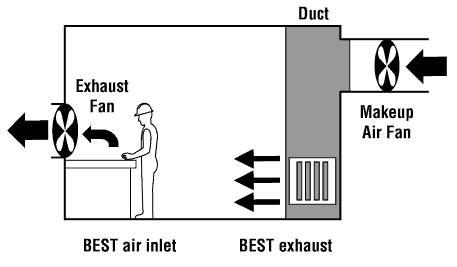
Figure 1
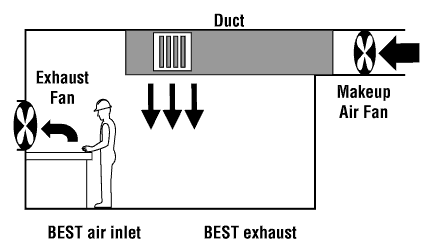
Figure 2
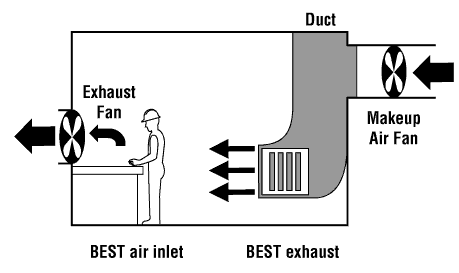
Figure 3
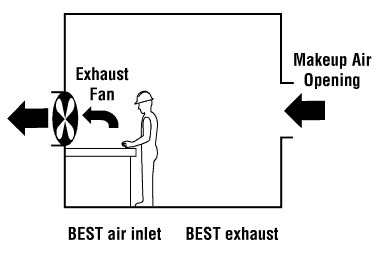
Figure 4
Figures 1 to 4: Examples of recommended dilution ventilation layouts
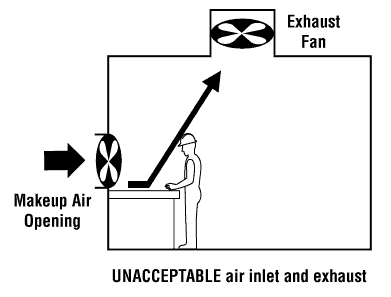
Figure 5
Example of dilution ventilation layout that is not recommended
What are the limitations of dilution ventilation?
Back to topAs a method for protecting workers, it is important to know that dilution ventilation:
- Does not completely remove contaminants.
- Cannot be used for highly toxic products.
- Is not effective for dusts or metal fumes or large amounts of gases or vapours.
- Requires large amounts of makeup air to be heated or cooled.
- Is not effective for handling surges of gases or vapours or irregular emissions.
As a general note, the air or "volumetric" flow rate of dilution ventilation depends largely on how fast the contaminant enters the air as well as the efficiency of the fresh air and workroom air mixing process.
It is common to use "floor" or "desk" fans as a method of ventilation or to provide comfort. Be aware that these fans typically blow the contaminant around the work area without effectively controlling it. Opening doors or windows can be used as dilution ventilation, but again, this method is not reliable since air movement is not controlled.
What is local exhaust ventilation?
Back to topLocal exhaust systems are used to control air contaminants by trapping them at or near the source, in contrast to dilution ventilation which lets the contaminant spread throughout the workplace. Local exhaust is generally a far more effective way of controlling toxic contaminants before they reach the worker's breathing zones. This type of system is usually the preferred control method if:
- Air contaminants pose a serious health risk.
- Large amounts of contaminants are generated.
- Increased heating costs from ventilation in cold weather are a concern.
- Emission sources are few in number.
- Emission sources are near the workers' breathing zones.
In a general way, a local exhaust system operates similar to a household vacuum cleaner with the hose as close as possible to the place where dirt would be created.
What are the components of local exhaust ventilation?
Back to topA local exhaust system has five basic elements (see Figure 6):
- The "hood" or opening that captures the contaminant at the source.
- Ducts that transport the airborne chemicals through the system (exhaust air) and the air that is recirculated.
- An air cleaning device that removes the contaminant from the moving air in the system (not always required).
- Fans that move the contaminated air through the system and discharges the exhaust air outdoors.
- An exhaust stack through which the contaminated air is discharged.
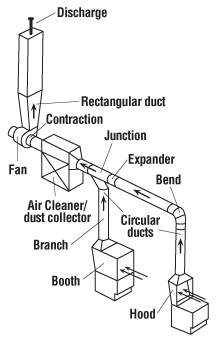
Figure 6
Components of a Local Exhaust Ventilation System
How do I know which type of ventilation system is best for my workplace?
Back to topAll industrial ventilation systems, when designed properly, should be able to provide long-term worker protection. The two types of ventilation, dilution and local exhaust, are compared in the following table.
| Comparison of Ventilation Systems | |||
|---|---|---|---|
| Dilution Ventilation | Local Exhaust Ventilation | ||
| Advantages | Disadvantages | Advantages | Disadvantages |
| Usually lower equipment and installation costs. | Does not completely remove contaminants. | Captures contaminant at source and removes it from the workplace. | Higher cost for design, installation and equipment. |
| Requires less maintenance. | Cannot be used for highly toxic chemicals. | The only choice for highly toxic airborne chemicals. | Requires regular cleaning, inspection and maintenance. |
| Effective control for small amounts of low toxicity chemicals. | Ineffective for dusts or metal fumes or large amounts of gases or vapours. | Can handle many types of contaminants including dusts and metal fumes. | |
| Effective control for flammable or combustible gases or vapours. | Requires large amounts of heated or cooled makeup air. | Requires smaller amount of makeup air since smaller amounts of air are being exhausted. | |
| Best ventilation for mobile or dispersed contaminant sources. | Ineffective for handling surges of gases or vapours or irregular emissions. | Less energy costs since there is less makeup air to heat or cool. | |
In general, what are limitations of any ventilation system?
Back to topSome limitations include:
- The systems deteriorate over the years because of contaminant build-up within the system, especially filters.
- Require ongoing maintenance.
- Regular and routine testing is needed to identify problems early and implement corrective measures.
- Only qualified persons should make modifications to a ventilation system to make sure the system continues to work effectively.
The following is an example of changes that can affect how a system works:
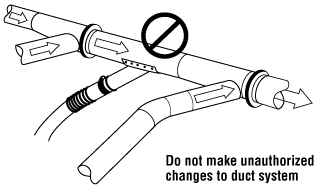
Figure 7
Addition of an exhaust duct branch
When an additional exhaust branch is added to an existing duct the local exhaust ventilation will pull air into the system from the new location. This change will reduce the airflow from other locations that are further away from the exhaust fan. The airflow through the entire ventilation system will be affected. This change may result in a rapid plugging of the system and in a reduction of the exhaust airflow, throughout all ducts. The system may no longer be adequate enough to remove the contaminants it was originally designed to remove.
What should I know about make-up air?
Back to topAn important and sometimes overlooked aspect of local ventilation is the need to provide enough air to replace the air that is exhausted from the workplace. If enough make-up air is not provided when large volumes of air are exhausted, the workplace becomes "starved" for air and negative pressure is created.
Negative pressure in the workplace increases resistance on the ventilation system causing it to move less air. Air will also enter a building through cracks around doors or windows or other small openings to try to "equal" the rate of air being removed. The result is that workers may be exposed to cold air in the winter, and additional heating costs may occur.
One way to figure out if a room is under negative pressure is to open the door about 3 millimetres and hold a smoke tube (or another object that releases a visible product in front of the opening. If the smoke is drawn into the room, the room is under negative pressure. If the smoke is pushed away from the room, the room is under positive pressure. If the smoke raises straight into the air, then the pressure in the room is the same as the outside pressure.
Another way to judge if a building is under excessive negative pressure is to open a door that pushes towards outside. If you have to pull (or push from inside) hard to open the door, the building is under negative pressure (the outside pressure is higher than inside, and forces the door shut).
If a building had negative pressure, a separate intake fan, located away from the exhaust fans, should be added to bring in fresh, uncontaminated air from outside. This air must be clean and heated in winter or cooled in summer, as needed.
In all cases, a ventilation specialist or building engineer should be consulted to implement solutions.
- Fact sheet last revised: 2023-05-01

